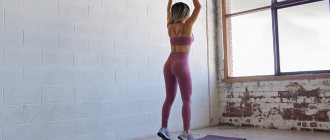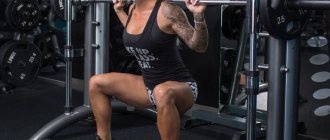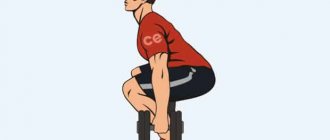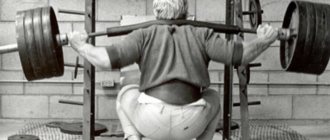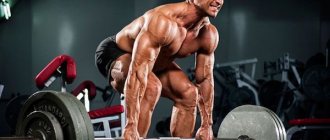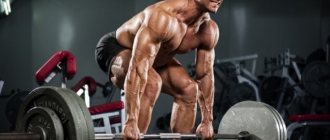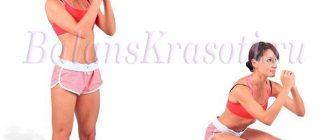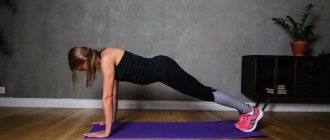Correct squats at home are included in almost any set of physical activities; they are one of the effective basic exercises that give noticeable and quick results. With its help, a beautiful hip line and expressive buttocks are formed, excess fat is removed from the lower body, and a lot of calories are burned. Additionally, performing at a fast pace speeds up the heart rate, which gives a significant cardio load. But how to squat correctly? How to do this exercise at home without a trainer?
The “Health” section is your detailed guide to healthy lifestyle issues. Training, nutrition, amateur sports - we have only the most important and useful information that will help you become better every day. Subscribe to our telegram channel to be the first to receive the latest articles.
Benefits of squats
Squats have a number of important benefits:
- slimness and fit of the lower body;
- stimulation of the production of growth hormone, due to which muscle mass quickly increases and relief is formed;
- strengthens the back muscles;
- posture improves;
- hip joints become flexible;
- lymph and blood flow accelerates;
- acceleration of metabolic processes;
- help strengthen the core and abdominal muscles;
- development of speed and strength.
Doing squats has a positive effect on endurance and develops proper balance and coordination of movements. All positive properties are achieved provided that the exercise is performed correctly. If the squatting technique is violated, the effectiveness significantly decreases.
Squats
The most important muscles in the squat are the quadriceps and glutes. In a barbell squat on the trapezius (upper back), they are loaded most effectively.
Squats with a barbell on the front delts shift the center of gravity to the quadriceps. Front squats are more often practiced by weightlifters. Beginning athletes are recommended to perform these exercises under the supervision of a trainer.
Types of squats
Once you have mastered the technique, you can make the workout more complex or varied in order to work the largest number of muscles in one session. The most common type of squats after the classic one is the plie.
How to squat “plie”: the technique is the same, only the legs are placed wider, and when squatting, the knees are spread to the side. This works the inner thighs.
There are other variations that can help you innovate your workouts while still maintaining their effectiveness.
Squats without weight
First, let's look at exercise options that are performed without additional load. They can be performed by beginners who have fully mastered the classical technique.
On one leg
Squats on one leg train not only muscles very well, but also balance and coordination of movements. In this variation, one leg is brought forward, and the arms are also brought forward to maintain balance. All the weight and load falls on the second leg. The exercise works the muscles twice as well.
The main thing is to learn not to fall to the sides when performing a squat on one leg. This is difficult; it is not easy for beginners and even advanced athletes to do it the first time.
With a jump
Straight squats with a jump and a 90- or 180-degree twist are a good variation for the workout. They are performed from the starting position of the classic exercise.
The difference is that you need to push harder with your toes, jumping up, then return to your heels again, lowering your pelvis. In turns of 180 and 90 degrees, you need to turn clockwise or counterclockwise while jumping.
The advantage of the exercise is that it increases the cardio load and works the upper thigh muscles better. The main thing is to ensure that during intense jumps, your back remains straight and your hips fall parallel to the floor, not lower or higher.
Burpee
Combined with squats, this is an exercise that allows you to work all muscle groups. It includes several elements of different exercises:
- bar;
- rock climber;
- squats.
It is performed from the starting “plank” position. You need to lie on the floor, rest your palms and toes on the floor, raise your body so that your back, pelvis and shoulders are in one straight line.
Then both legs are pulled to the chest, and through a squat you need to take a vertical position.
Then sit down again, rest your hands on the floor, return your legs to their original position.
Squats for weight loss at home
Classes are held regularly. Before performing the exercises, do a light warm-up. To maximize the load on the muscles and preserve the joints, it is important to follow the technique. How to do proper squats for weight loss at home:
- The exercise resembles the movement when you sit down on a chair - your thighs and shins should form a right angle of 90 degrees, your heels pressed firmly to the floor.
- Keep your back flat and straight to properly distribute the load.
- Do squats while inhaling deeply and evenly, and return to the starting position as you exhale.
The set of exercises, the number of repetitions and approaches, the intervals between exercises depend on the amount of extra pounds, the individual characteristics of the body, and general physical fitness. An effective squat program for weight loss at home:
- Beginners start doing squats 10 times in 1 approach, i.e. 60 squats a day.
- Every 3 days add 2-5 squats. The first days add two squats, after two weeks of training - five. Increase the number of approaches if the exercise does not cause difficulties.
- By the end of the month the amount is increased to 200 times.
- Take a break every 3 days.
The right feeling at the end of classes is a pleasant tension in the body. Severe muscle pain indicates errors when performing squats, an illiterate program, and uneven distribution of the load. Overvoltage will not give the desired result. The effect of squats is achieved only by systematically performing the exercise.
Classic squats
It is better to start training with this type of exercise. When the muscles become more resilient, you can squat deeper, with lunges, diversify your leg positioning, or squat on one leg, use dumbbells. Technique for performing classic squats for weight loss:
- Starting position: legs straight, shoulder-width apart, heels touching the floor, arms straight, extended parallel to the horizontal surface, keep the body straight, head looking forward.
- The back is straight, the shoulders are lowered and laid back. To take the correct position of the body, make a semicircle with your shoulders back.
- When squatting, tilt your body forward for balance.
- The knees should not go beyond the toes, the thigh line should be parallel to the floor.
For slimming legs
To remove fat deposits from the inner and outer thighs, perform the plie exercise. It improves blood circulation in the pelvis and improves coordination. Perform squats to lose weight on your legs without weights. Technique:
- Stand up straight with your feet wider than shoulder-width apart, knees slightly bent and apart, feet turned outward at an angle of 45 degrees.
- As you inhale, lower yourself, slowly bending your knees, until your thighs are parallel to the floor.
- Perform the exercise until you feel the adductor muscles stretch.
- As you exhale, rise up, pushing your heels off the floor.
- Repeat plie squats 10-20 times.
Squats with weight
When doing large amounts of squats is easy, additional load needs to be added. In order for muscles to grow, they must constantly work at their maximum capacity. Increasing the number of squats beyond 200 will take up the lion's share of training time, and the benefits will gradually decrease. To help you can choose:
- dumbbells (at home you can replace them with a water bottle with a comfortable grip);
- barbell;
- weights for legs, belt, arms.
The easiest way to do this is with dumbbells in your hands. The technique remains similar to the classic version or any other; you need to take additional weight in your hands. When lowering, the dumbbell in your hands should fall down between your legs. When rising, return to the position in front of you. You can take two dumbbells in both hands.
If classes are held in the gym, a barbell with the selected weight (you need to start with small weights or even an empty bar) is lifted behind your head and placed on your shoulders. The technique is the same as in the classic version. Other options for performing the exercise, except for the plie, are traumatic.
You can perform any squats with weights; the technique does not matter. They can be classic, on one leg, plie or with turns. Don't take on too much weight right away. With additional load in the first workout, you should do the usual amount. If 200 loaded squats every day is difficult, you need to reduce the load.
Contraindications
Squats are even used in children's exercise routines and in physical education classes. Despite its versatility and high efficiency, there are a number of contraindications for which training is not recommended:
- there are problems with the joints of the lower extremities;
- varicose veins;
- large body weight, which creates too much stress on the knees and ankles;
- diseases, hernias, injuries and damage to the spine;
- hypertension, pressure changes.
You should also consult a doctor if you have cardiovascular diseases or chronic diseases. If discomfort or severe pain or shortness of breath appears during the exercise, it is better to exclude squats from the physical complex.
Monthly squat training plan
In just 6 weeks you can reach 200 squats a day, which seems unrealistic for beginners. The athlete is required to follow the principle of gradualism. You need to add no more than 5 squats every day. The muscles will get used to the increased load without pain.
It is imperative to take a rest day so that the muscle fibers can recover. Without rest, they will not grow and develop correctly. After a rest day, start with the same number of squats that were the maximum before the rest day to consolidate the results and move on calmly.
30 Day Squat Plan for Toned Butts
| Day | Quantity | Day | Quantity |
| 1 | 50 | 16 | 95 |
| 2 | 55 | 17 | 100 |
| 3 | 60 | 18 | 105 |
| 4 | 65 | 19 | 110 |
| 5 | Rest | 20 | Rest |
| 6 | 65 | 21 | 110 |
| 7 | 70 | 22 | 115 |
| 8 | 75 | 23 | 120 |
| 9 | 80 | 24 | 125 |
| 10 | Rest | 25 | Rest |
| 11 | 80 | 26 | 125 |
| 12 | 85 | 27 | 130 |
| 13 | 90 | 28 | 135 |
| 14 | 95 | 29 | 140 |
| 15 | Rest | 30 | Rest |
Now you know how to squat correctly. Beginners need to pay special attention to developing the correct technique. For this exercise, it is better to do it in front of a mirror to see if your back is rounded, if your knees protrude beyond the line of your toes, if your knees point inward or are parallel. If you avoid mistakes in the first stages, this will allow you to quickly and effectively pump up your lower body and get visible results.
200 squat program
This complex is for those who ultimately want to squat 200 times in one day. Suitable for intermediate and advanced levels of training. You need to squat 3 times a week. Make sure you have rest and recovery time between these days.
| A WEEK | NUMBER OF SQUATS |
| 1 week → | do 23 squats on the first and second days, and 28 on the third |
| Week 2 → | first day perform 32 squats, second - 34, third - 43 |
| Week 3 → | first day - 2 sets of 30 times. Second - 2 sets of 35 times. Third - 2 sets of 40 times |
| Week 4 → | first day - 2 sets of 45 times. The second is 2 sets of 50 times. Third - 2 sets of 55 reps |
| Week 5 → | first day - 2 sets of 60 times, second - 2 sets of 65 times, third - 2 sets of 70 times |
| Week 6 → | first day - 3 sets of 55 times, second - 3 sets of 65 times, third - 3 sets of 75 times |
To withstand such a heavy load, it is necessary to strengthen the joints. We recently shared exercises and tips for strengthening your joints.
